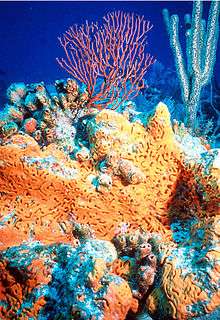Holozoa
| Holozoans Temporal range: Ediacaran - Present, 610–0 Ma | |
|---|---|
 | |
| Orange elephant ear sponge, Agelas clathrodes, in foreground. Two corals in the background: a sea fan, Iciligorgia schrammi, and a sea rod, Plexaurella nutans. | |
| Scientific classification | |
| (unranked): | Opisthokonta |
| (unranked): | Holozoa Lang et al. 2002 |
| Subgroups | |
| |
Holozoa is a group of organisms that includes animals and their closest single-celled relatives, but excludes fungi.[1][2][3][4] Holozoa is also an old name for the tunicate genus Distaplia.[5]
Because Holozoa is a clade including all organisms more closely related to animals than to fungi, some authors prefer it to recognizing paraphyletic groups such as Choanozoa, which mostly consists of Holozoa minus animals.[6]
Perhaps the best-known holozoans, apart from animals, are the choanoflagellates, which strongly resemble the collar cells of sponges, and so were theorized to be related to sponges even in the 19th century. Proterospongia is an example of a colonial choanoflagellate that may shed light on the origin of sponges.
The affinities of the other single-celled holozoans only began to be recognized in the 1990s.[7] A group of mostly parasitic species called Icthyosporea or Mesomycetozoea is sometimes grouped with other species in Mesomycetozoa (note the difference in the ending). The amoeboid genera Ministeria and Capsaspora may be united in a group called Filasterea by the structure of their thread-like pseudopods. Along with choanoflagellates, filastereans may be closely related to animals, and one analysis grouped them together as the clade Filozoa.[3]
Fossil record
The oldest fossils of holozoans are animals, which date back to the Ediacaran period, about 600 million years ago.[8]
Cladogram
The most up to date cladogram is[9][10]
| Opisthokonta |
| ||||||||||||||||||||||||||||||||||||||||||||||||||||||||||||||||||
| |
References
- ↑ Aleshin VV, Konstantinova AV, Mikhailov KV, Nikitin MA, Petrov NB (December 2007). "Do we need many genes for phylogenetic inference?". Biochemistry Mosc. 72 (12): 1313–23. doi:10.1134/S000629790712005X. PMID 18205615.
- ↑ Lang BF, O'Kelly C, Nerad T, Gray MW, Burger G (October 2002). "The closest unicellular relatives of animals". Curr. Biol. 12 (20): 1773–8. doi:10.1016/S0960-9822(02)01187-9. PMID 12401173.
- 1 2 Shalchian-Tabrizi, Kamran; Minge, Marianne A.; Espelund, Mari; Orr, Russell; Ruden, Torgeir; Jakobsen, Kjetill S.; Cavalier-Smith, Thomas; Aramayo, Rodolfo (7 May 2008). Aramayo, Rodolfo, ed. "Multigene phylogeny of choanozoa and the origin of animals". PLoS ONE. 3 (5): e2098. doi:10.1371/journal.pone.0002098. PMC 2346548
 . PMID 18461162.
. PMID 18461162. - ↑ Elias M, Archibald JM (August 2009). "The RJL family of small GTPases is an ancient eukaryotic invention probably functionally associated with the flagellar apparatus". Gene. 442 (1–2): 63–72. doi:10.1016/j.gene.2009.04.011. PMID 19393304.
- ↑ Tatiàn, Marcos; Antacli, Julieta Maria; Sahade, Ricardo (2005). "Ascidians (Tunicata, Ascidiacea): species distribution along the Scotia Arc". Scientia Marina. 69 (suppl. 2): 205–214.
- ↑ Steenkamp, Emma T.; Wright, Jane; Baldauf, Sandra L. (January 2006). "The Protistan Origins of Animals and Fungi". Molecular Biology & Evolution. 23 (1): 93–106. doi:10.1093/molbev/msj011. PMID 16151185.
- ↑ Ragan, Mark A.; Goggin, C. Louise; Cawthorn, Richard J.; Cerenius, Lage; Jamieson, Angela V.C.; Plourde, Susan M.; Rand, Thomas G.; Söoderhäll, Kenneth; Gutell, Robin R. (15 October 1996). "A novel clade of protistan parasites near the animal-fungal divergence". PNAS. 93 (21): 11907–11912. doi:10.1073/pnas.93.21.11907. PMC 38157
 . PMID 8876236.
. PMID 8876236. - ↑ Porter, Suzannah M. (2004). "The fossil record of early eukaryotic diversification". Paleontological Society Papers. 10: 35–50.
- ↑ Parfrey, Laura Wegener; Lahr, Daniel J. G.; Knoll, Andrew H.; Katz, Laura A. (16 August 2011). "Estimating the timing of early eukaryotic diversification with multigene molecular clocks". Proceedings of the National Academy of Sciences. 108 (33): 13624–13629. doi:10.1073/pnas.1110633108. ISSN 0027-8424. PMC 3158185
 . PMID 21810989.
. PMID 21810989. - ↑ Torruella, Guifré; de Mendoza, Alex; Grau-Bové, Xavier; Antó, Meritxell; Chaplin, Mark A.; del Campo, Javier; Eme, Laura; Pérez-Cordón, Gregorio; Whipps, Christopher M. (21 September 2015). "Phylogenomics Reveals Convergent Evolution of Lifestyles in Close Relatives of Animals and Fungi". Current Biology. 25 (18): 2404–2410. doi:10.1016/j.cub.2015.07.053. ISSN 0960-9822.